Personal tools
News from ICTP 96 - Dateline

The ICTP Mathematics Group has received a US$27,000 grant from
the European Commission (EC) and a US$23,000 grant from the US
National Science Foundation (NSF) to fund the cost of participation
of young European and American scientists, respectively, in the
Centre's School on High-Dimensional Manifold Topology. The School
will be held in Trieste from 21 May to 8 June. Meanwhile, Brazil's
National Research Council (CNPq) will increase its annual grant
to the ICTP Mathematics Group from US$40,000 to US$50,000. The
funds will be used to cover the cost of participation for Brazilian
scientists in the ICTP School on Dynamical Systems (30 July to
17 August) and other Centre-based activities in mathematics and
physics.
ICTP has issued a call for proposals from the scientific community for the organisation of schools, workshops and conferences in all fields of theoretical physics and mathematics as well as in subjects outside of those fields that make extensive use of the tools of physics and mathematics. The latter include weather and climate research, nuclear data and applications, mathematics of economics and computer science. For more detailed information, please contact proposals@ictp.trieste.it.
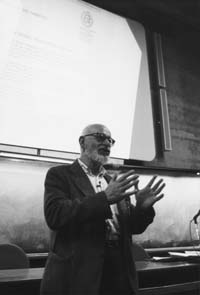
Francesco Calogero, professor of physics at the University of Rome La Sapienza, spoke in the ICTP Main Lecture Hall on 26 February on issues related to nuclear weapons development and control. Calogero serves as Chairman of the Pugwash Council (1997-2002). Pugwash received the Nobel Prize for Peace in 1995. In his lecture, Calogero noted that the number of nuclear warheads has declined from a peak of 70,000 in 1986 to about 30,000 today.
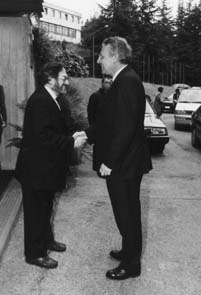
ICTP director Miguel Virasoro welcomes Philippe Busquin
Philippe Busquin, the European Union's (EU) Commissioner for Research, visited ICTP on 16 February as part of a one-day tour of scientific institutions in Trieste. The Commissioner met with ICTP director Miguel Virasoro and members of ICTP's research groups to discuss ways that the EU and ICTP could work together to promote scientific cooperation between developing countries and Europe. Two areas of particular interest to the Commissioner were the ICTP Training and Research in Italian Laboratories (TRIL) programme and the Centre's involvement in the EU's PROMISE programme, which focusses on the predictability and variability of monsoons and the agricultural and hydrological impacts of climate change.
The ozone hole over Antarctica could heal in some 50 years,
according to an international panel of scientists chaired by Alan
O'Neill, director of the Centre for Global Atmospheric Modelling,
University of Reading, UK. The recent announcement strongly suggests
that the global effort to reduce the use of chlorofluorocarbons
(CFCs), launched in 1987, is succeeding.
Two of the scientists who made major contributions to the understanding
of the processes that influence the atmosphere's ozone content
visited ICTP during the past few months: Dutch-born Paul J.
Crutzen and American-born F. Sherwood Rowland. In 1995,
they shared the Nobel Prize for chemistry with Mario J. Molina
(also from the United States) for their pioneering work in atmospheric
chemistry, particularly concerning the formation and depletion
of ozone.
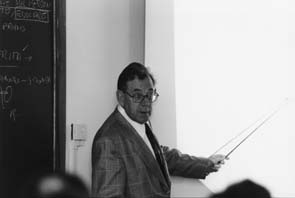
Paul Crutzen
Crutzen recently stepped down as director of the Max Planck Institute
for Chemistry in Mainz, Germany, and now serves as co-chief scientist
of INDOEX, the Indian Ocean Experiment that since 1995 has been
collecting data from satellites, aircraft, balloons, ships and
island stations to provide information about the complex influence
of aerosol cooling on global warming. INDOEX is supported by universities
and national laboratories from the United States, Europe and the
Indian Ocean region.
INDOEX's activities were the main topic of discussion at the special
seminar on "The Importance of the Tropics in Atmospheric
Chemistry and How It Is Impacted by Human Activities," which
Crutzen delivered at ICTP on 25 October 2000. In 1970, Crutzen
showed that nitrogen oxides react catalytically with ozone, thus
accelerating the rate of reduction of the ozone content in the
atmosphere. During the same period, he pointed out the possible
threat to the ozone layer created by civil supersonic aircraft
because of the releasing of nitrogen oxides in the middle of the
ozone layer at altitudes of 20 kilometres.
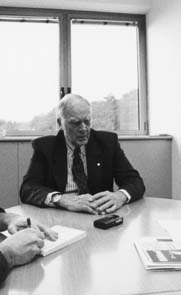
F. Sherwood Rowland
F. Sherwood Rowland, who is the foreign affairs chairperson of
the US National Academy of Sciences, attended the first meeting
of the InterAcademy Panel's (IAP) Executive Committee that took
place at ICTP at the end of January (see page 14). With colleagues
from the University of California at Irvine, Rowland is now analysing
the air in some 25 megacities worldwide to identify the sources
of urban pollution.
"We also hope to use this data," explains F. Sherwood
Rowland, "to study the effects of rising levels of carbon
dioxide on climate change. The Earth's temperature has increased
by about 0.7°C since 1880, due in part to the release of carbon
dioxide during industrial activities. For the near future, I put
no great trust in solar or wind energy. But we may be able to
'imprison' carbon dioxide in underground cavities or beneath the
seas. Research on such potential mitigation strategies are already
taking place in Norway, for instance."
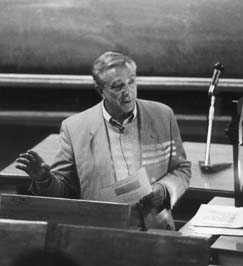
John Casti, of the University of Vienna (Austria) and the Santa Fe Institute (USA), presented a public lecture at the ICTP Main Lecture Hall on 29 March focussing on the 'would-be' behaviour of complex systems ranging from traffic patterns to stock markets to rainforests. Casti contends that high-powered computers now give us the ability to create surrogate versions of real complex systems--artificial worlds, if you will--that are analogous to the more familiar laboratories that have been used by physicists, biologists and chemists for centuries to understand the workings of matter and nature. The difference is that these new computerised laboratories allow us to explore the informational rather than the material structure of systems. The result, according to Casti, is that for the first time in history we may now be in the position to realistically think about the creation of a theory of complex systems.